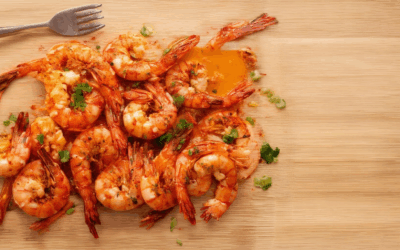Discover the vibrant world of Mediterranean cuisine with its rich tapestry of flavors and the perfect partners to complement them—fish. From the sun-kissed shores of the Mediterranean Sea comes a unique culinary tradition that transforms simple fish into delightful feasts of taste. Whether you’re a seasoned food enthusiast or new to the charm of Mediterranean cooking, the combination of bold spices, fresh herbs, and centuries-old techniques creates a dining experience unlike any other. In this guide, we delve into the best fish varieties that thrive in the Mediterranean climate, uncovering the secrets behind their flavor profiles and how to bring them to life in your kitchen. Prepare to embark on a journey where every bite tells a story of sun, sea, and tradition, as we explore the top picks for fish with Mediterranean flavors and the expert tips to cook them perfectly.

What is a Good Mediterranean Fish?
The Mediterranean diet is renowned for its emphasis on healthy fats, fruits, vegetables, whole grains, and lean proteins. Among these, several fish stand out as excellent choices that align with the dietary principles of the Mediterranean lifestyle. These fish not only provide essential nutrients but also fit seamlessly into the region’s culinary traditions.
Here are some standout Mediterranean fishes:
-
Salmon : Known for its high omega-3 fatty acid content, salmon is a prime choice. It’s featured in dishes like Salmon with Lemon and Olive Oil , a classic Italian preparation.
-
Mackerel : Another fatty fish rich in omega-3s, mackerel is celebrated for its heart-healthy benefits. It’s often enjoyed in Spanish and Portuguese cuisines, typically grilled or marinated.
-
Sardines : These small, oily fish are packed with nutrients and are a staple in Mediterranean diets. They can be found in various recipes, such as Sardine Tapas , a popular Spanish dish.
-
Bream : A favorite in Greek cuisine, bream is noted for its tender texture and high protein content. It pairs well with herbs and olives, as seen in traditional Greek dishes.
-
Shrimp and Octopus : Common in Southern European and Mediterranean cuisines, these seafood items are versatile and nutritious. Shrimp can be grilled or sautéed with garlic and olive oil, while octopus is often cooked with rice and vegetables.
These fish are not only celebrated for their nutritional value but also for their cultural significance in the Mediterranean region. They are typically prepared through grilling, baking, or pan-searing with olive oil, often accompanied by whole grains, fresh vegetables, and sometimes feta cheese or hummus, completing a balanced and flavorful meal.
What is the most beautiful Mediterranean fish?
The Mediterranean region is home to an incredible variety of fish, each with unique beauty and characteristics. Among them, the parrotfish stands out as one of the most striking due to its vivid, almost fluorescent colors. These hues serve as both camouflage and a dramatic display for males during breeding season.
- Parrotfish : Renowned for their vibrant colors, parrotfish are often compared to tropical reef fish. Their appearance varies by gender and species, making them a favorite among marine enthusiasts.
- Spanish Mackerel : Known for its iridescent scales that shimmer in shades of purple, green, and gold, the Spanish mackerel is another contender for the title of Mediterranean beauty.
- Bluefin Tuna : While less colorful than the others, the bluefin tuna’s sleek, torpedo-shaped body and deep blue hue make it a fascinating sight in the open ocean.
Each of these fish contributes uniquely to the Mediterranean’s underwater beauty, offering a diverse range of colors and forms that captivate divers and researchers alike. For those interested in learning more about these species and their culinary uses, visit our seafood recipe hub .

Edible Fish in the Mediterranean
- Anchovy
- Sardine
- Mussel
- Clam
- Shrimp
- Lobster
- Tuna
- Salmon
- Mackerel
- Eel
- Cuttlefish
- Whiting
- Tilapia

What are the classic Mediterranean flavors?
Mediterranean cuisine is renowned for its rich and diverse flavors, which reflect the region’s history, climate, and cultural influences. Here are the key components that define classic Mediterranean flavors:
1. Fresh Herbs
- Basil
- Oregano
- Rosemary
- Thyme
- Sage
- Bay leaves
- Mint
- Lemon thyme
- Dill
2. Fruits and Vegetables
- Tomatoes
- Cucumbers
- Zucchini
- Eggplant
- Peppers
- Onions
- Garlic
- Apples
- Oranges
- Figs
- Olives
3. Cheeses and Dishes
- Feta cheese
- Mozzarella di bufala
- Parmesan
- Greek yogurt
- Hummus
- Tahini
- Kebabs
- Pita
- Baklava
- Spanakopita
4. Spices and Herbs
- Cumin
- Coriander
- Paprika
- Chili flakes
- Cinnamon
- Nutmeg
- Cloves
- Cardamom
- Cayenne pepper
5. Olive Oil and Vinegar
- Extra virgin olive oil
- Balsamic vinegar
- Red wine vinegar
- Herb-infused oils
- Lemon-infused oils
These flavors and ingredients have been harmonized over centuries, creating a unique taste profile that is both robust and delicate, perfect for a variety of dishes.
Mediterranean Flavors
The Mediterranean region is renowned for its rich and diverse culinary traditions, characterized by a unique blend of herbs, spices, and ingredients that have been refined over centuries. These flavors are deeply rooted in the history and culture of the region, offering a harmonious balance of bitterness, sweetness, and umami that make dishes distinctly Mediterranean.
Herbs
Meditteranean cuisine relies heavily on a variety of fresh herbs to impart vibrant flavors and aromas. Some of the most commonly used herbs include:
- Rosemary
- Thyme
- Oregano
- Mint
- Marjoram
- Sage
- Basil
- Cilantro
- Dill
- Fennel
Spices
Spices play a crucial role in enhancing the complexity of Mediterranean dishes. Some popular spices used in the region are:
- Paprika
- Cumin
- Coriander
- Chili flakes
- Turmeric
- Ginger
- Cinnamon
- Nutmeg
- Cardamom
Ingredients
The foundation of many Mediterranean dishes lies in the use of high-quality ingredients, such as:
- Extra virgin olive oil
- Fresh vegetables like tomatoes, cucumbers, zucchini, and bell peppers
- Grains such as rice, couscous, and pasta
- Fresh cheeses like feta, mozzarella, and ricotta
- Legumes including chickpeas, lentils, and black beans
- Seafood and meats, often grilled or roasted
Traditional Dishes
Some iconic Mediterranean dishes that highlight these flavors include:
- Paella (a rice dish with seafood, saffron, and vegetables)
- Moussaka (a layered dish with eggplant, ground meat, and tomato sauce)
- Tabbouleh (a bulgur salad with herbs, lemon juice, and olive oil)
- Spanakopita (a phyllo pastry filled with spinach and feta cheese)
- Baklava (a sweet pastry with layers of honey, nuts, and phyllo dough)
How to Use These Flavors
Incorporating Mediterranean flavors into your cooking can elevate your dishes to new heights. Here are a few tips:
- Use fresh herbs generously for a brighter taste.
- Combine spices in small amounts to avoid overwhelming the dish.
- Add a pinch of sugar or honey to balance the savory flavors with sweetness.
- Pair bold spices with mild ingredients to create a perfect harmony.
By embracing the rich tapestry of Mediterranean flavors, you can create meals that are not only delicious but also culturally meaningful. Whether you’re preparing a simple appetizer or a grand feast, these ingredients offer endless possibilities for experimentation and creativity.

What is the Mediterranean Trinity of Foods?
The Mediterranean trinity of foods refers to the three core ingredients that form the foundation of traditional Mediterranean cuisine: olive oil , wheat , and grapes . These ingredients have been central to the culinary traditions of the region for centuries, contributing to a diet rich in flavor, nutrition, and cultural significance.
1. Olive Oil
Olive oil is the cornerstone of Mediterranean cooking. Derived from the olive tree, it serves as a versatile base for countless dishes, from salads to sauces. The olive oil used in the Mediterranean is typically extra virgin, which means it is cold-pressed and contains minimal processing. Regions like Italy, Spain, and Greece are known for their high-quality olive oils, which are rich in antioxidants and healthy fats. Olives have been cultivated in the Mediterranean for thousands of years, with evidence of olive oil production dating back to ancient civilizations.
2. Wheat
Wheat is the primary source of carbohydrates in the Mediterranean diet. It is used to make bread, pasta, and couscous, among other staples. Whole grains, such as whole wheat and farro, are particularly emphasized for their nutritional benefits. Wheat has been a staple in the region since ancient times, playing a crucial role in the development of various cuisines. Pasta, for example, originated in Italy and has become a symbol of Italian cuisine worldwide.
3. Grapes
Grapes are the fruit of the vine and are used to produce wine, a beverage deeply rooted in Mediterranean culture. Wine has been a part of social and religious ceremonies, as well as daily life, for millennia. Red wines, such as those from Italy and France, are often paired with meals to complement flavors and enhance dining experiences. Grapes also contribute to the region’s reputation for producing some of the world’s finest wines, with regions like Bordeaux and Tuscany renowned for their winemaking traditions.
The Evolution of the Mediterranean Diet
The Mediterranean trinity reflects the region’s unique climate and agricultural capabilities. The mild winters and fertile soil of the Mediterranean make it ideal for growing olives, grapes, and wheat. Over time, these ingredients have been integrated into dishes that highlight their flavors and nutritional properties. The combination of these three ingredients creates a balanced and flavorful cuisine that has influenced cooking traditions around the world.
Conclusion
The Mediterranean trinity of foods—olive oil, wheat, and grapes—is not just a dietary foundation but also a cultural identifier. These ingredients have shaped the region’s culinary heritage, offering a nutritious and delicious way of life. From ancient times to the present, they continue to be central to the vibrant and varied dishes of the Mediterranean.




0 Comments